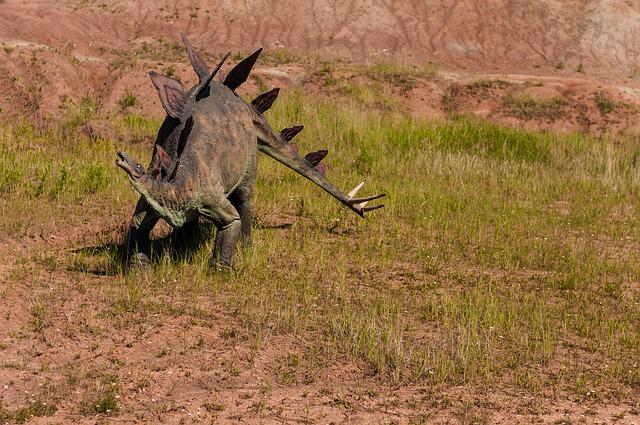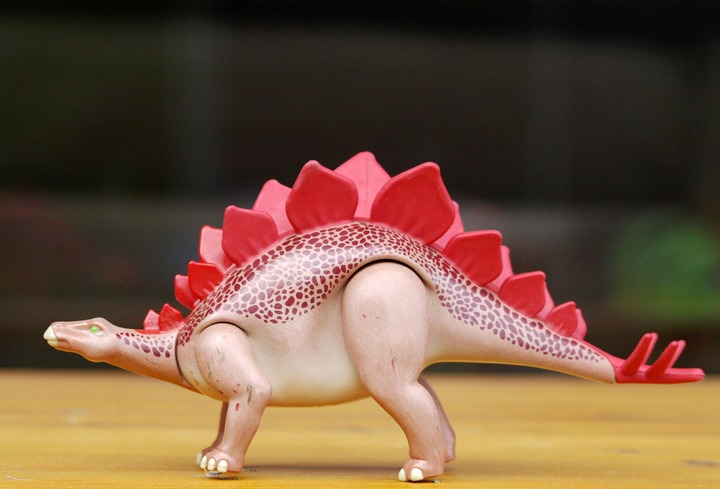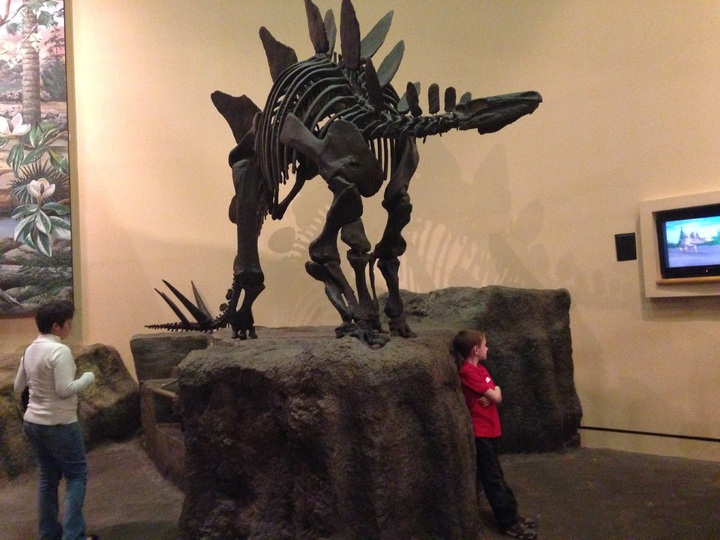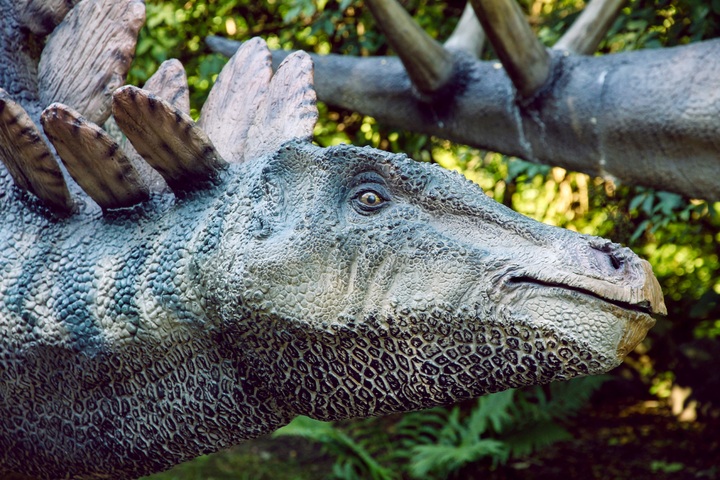12 Amazing Stegosaurus Facts For Kids [Shocking Facts] 2024
The Stegosaurus was a giant dinosaur that existed roughly 150.8-155.7 million years ago during the Late Jurassic Period. Professor Othniel Marsh discovered the Stegosaurus’s first fossil in 1877. He discovered large, bony scales on its back that reminded him of roof tiles and came up with the name Stegosaurus, meaning ‘roofed lizard.’
A Stegosaurus had two rows of skeletal scales along the length of its body, and it was the length of a bus. This dinosaur species was discovered initially in Colorado’s western North America range.
Keep reading below to know more about such interesting facts about Stegosaurus.

12 Interesting Stegosaurus facts for kids
Stegosaurus lived in a terrestrial habitat.
Stegosaurus dinosaurs lived a significant part of their life in a terrestrial habitat in the Mexico and southern US regions and western North America. In addition, according to a study on dinosaur species, streams and historic rivers are considered to have been the favored regions for Stegosaurus habituation.
They lived upon densely vegetated swamps, natural forested floodplains, wooded area segments, seasides, and lakes. The Stegosaurus’ wildlife areas further had resources to cater to its more than average hunger.
Stegosaurus was primarily a herbivore.
Predominantly herbivore, Stegosaurus fed on low-lying herbs. They munched grass and were primarily dependent on ferns for survival. The browser of the Jurassic Era, the Stegosaurus, focused on soft vegetation. It had pointed teeth but not a powerful jaw to cope with the green diet.
In addition, scientists believe that Stegosaurus’s fossilized teeth in the skeleton indicate that sharp teeth made it effortless to tear vegetation and plants. The Stegosaurus held a strong gut responsible for the breakdown of nutrients and its digestion assisted by gastroliths. They also used their rear legs to graze on trees or detect threats. Furthermore, this quadrupedal animal would likely have had to eat hundreds of pounds of cycads and herbs daily to keep its presumably cold-blooded metabolism.
Stegosaurus is known for its distinct body structure.
Stegosaurus is well-known for its big, rhombus-shaped skeletal scales over its body, rising from its neck to the tail. Moreover, the Stegosaurus dinosaur used its sharp tail to guard itself against predators such as the Ceratosaurus and Allosaurus that preyed on it. Nevertheless, the giant black plates, also known as scutes, may not have been used as a shield and an aesthetic attribute to attract partners.

Stegosaurus was moderately aggressive.
Stegosaurus had tolerant defensive techniques like pivoting its tail for safety. They had a herbivorous, plant-based diet that natural resources could fast supply. These qualities of the Stegosaurus display that they were moderately aggressive creatures. They exhibited thermoregulation, indicating they could control their body temperature through the blood rushing in their blood vessels.
The complete Stegosaurus skeleton went on exhibition in 2014
The entire Stegosaurus skeleton found went on exhibition in December 2014 in the Natural History Museum’s Earth Hall. It was pinpointed by a member of the species Stegosaurus stenops, assisting researchers in discovering more facts about this dinosaur species. Furthermore, this comprises details such as how Stegosaurus walked and ate, what it might have looked like when it was alive, and its behavioral habits.

Stegosaurus roamed in Portuguese terrain.
Even when the Stegosaurus initially existed in the United States, there is a substantial indication that it wandered the Portuguese terrain approximately 150 million years ago!
Scientists believe that Stegosaurus had cheeks.
Scientists believe that the Stegosaurus is one of the few dinosaur species that had cheeks! It allowed them to chew and pre-digest their meals before swallowing them exhaustively. It helped them store more vegetable matter than other species that didn’t have cheeks.
Stegosaurus mainly prevailed in the USA.
According to different scientific findings, the Stegosaurus dinosaur fossils have been found in the Morrison Formation, Colorado, USA, Montana-Hell Creek Formation, Wyoming-Ferris Formation, New Mexico-Kirtland Formation, and Portugal-Alcobaça Formation parts of the world. It’s also safe to assume that researchers and scientists will continue to find more dinosaur fossils as technology advances over time!
Stegosaurus co-existed with other dinosaur species.
The Stegosaurus dinosaur fossil specimen was discovered from the Middle to Late Jurassic era with other dinosaur species like Diplodocus, Apatosaurus, Brachiosaurus, Ceratosaurus, and Allosaurus. It is thought they resided perhaps in the same area as them. In addition, Ceratosaurus and Allosaurus are said to have preyed on the Stegosaurus. While it might surprise some readers, it wasn’t uncommon for some dinosaur species to coexist with others, especially when considering the fact that the different species existed in similar time periods.
Stegosauruses usually communicated by hissing.
It is not known precisely how the Stegosaurus or dinosaurs of distinct species interacted. However, Philip J. Senter, an American professor of Zoology at Fayetteville State University, in research on the paleobiology of dinosaurs, expressed that dinosaurs used to communicate by clapping and hissing. The American professor further believed that Stegosaurus brushed the jaws against the upper jaw, stroked scales against each other, and employed environmental resources such as sloshing in the water. In addition, Dinosaurs are also considered to have interacted vocally and visually. These two types of interaction were most generally used during courtship, defensive posture and territorial fighting.

Stegosaurus usually has a small brain.
Except for a few, almost every dinosaur species is considered not to have been mainly clever, Stegosaurus included. This age-old creature was known to have a small, narrow head, which only had little room for a brain. A prevalent Stegosaurus fact is that this dinosaur’s brain was the dimensions of a walnut. Yes! It was that tiny! Nevertheless, recent research has demonstrated that it was closer to the dimensions and form of a hotdog (Yet, this is very small compared to Stegosaurus’s oversized physique!). More so, paleontologists and scientists had a challenging time covering their intellects around the small-sized brain of Stegosaurus.
Experts believed that Stegosaurus swallowed stones.
It is believed that the mighty Stegosaurus swallowed rocks to assist the digestion of plants and herbs. While it might seem uncommon that rocks were deemed digestible to these old animals, scientists believe that eating small rocks, and pebbles helped the stegosaurus digest the greens and other plant matter they consumed daily.
Conclusion
Any assumptions that might have prevailed about the Stegosaurus are now out in the open! These distinctive creatures might have lived millions of years ago, but the reality that their legacy is still discussed in modern times is a testament to the influence they left behind. We hope this article encouraged you to learn more about the stegosaurus and other dinosaurs!
